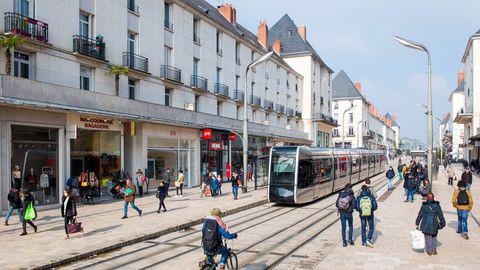
4 minute read
Case studies
CASE STUDY: CROYDON
The Croydon Tramlink, built in 2000 by a consortium under a PFI contract, was bought by Transport for London in 2008 who subsequently renamed it London Tramlink.
Advertisement
The tram network, based in central Croydon, includes one branch west to Wimbledon and three east, to New Addington, Elmers End and Beckenham Junction. The network is twenty eight kilometres long and includes two converted railway branches, a section alongside an active line, and a section of abandoned railway route. The central one-way loop in Croydon is entirely on street.
There are 39 accessible stops, long enough and wide enough to be used safely by all passengers. Information boards display live estimated times of arrival for the next two trams, with covered seating and lighting provided for comfort.
The 36 trams are powered by overhead lines. The original order of twenty four 30 metre trams were complemented by an order of twelve 32 metre trams to accommodate increased traffic. The system is fully integrated into the TFL network, with contactless ticketing and common fares across the other TFL modes.
The Tramlink has been very successful. As tram use increased, road traffic reduced and retail revenues rose. Annual travel on the network rose steadily from 18 million journeys in the first year to 31 million in 2013/14.
Importantly, many complex journeys are now taking place on the network, demonstrating the ability of the tram to change travel behaviour. People increasingly board and alight at intermediate stops, demonstrating that it is not just the main urban centres which benefit from such schemes.
Croydon demonstrates that it is possible and desirable to re-establish redundant rail routes in the British setting, and the remarkable shift in behaviour when public transport is convenient and reliable. Croydon’s trams are modern, accessible, well equipped and extremely popular.
Live updates are provided which increase customer satisfaction and assist those without smartphones.

The tram is fully integrated with the wider TFL network, allowing contactless payment and standardised fares.

CASE STUDY: TOURS
Tours, situated on the River Loire in France, is a city of 140,000 people and a wider conurbation of 480,000. It is a renowned cultural centre with significant employment in service and manufacturing industries in the outskirts.
The Tours tramway serves substantial modern urban housing areas at its northern and southern ends, and notably a new development immediately south of Tours railway station. It also serves older areas north and south of Tours and in Joue-les-Tours. It further connects with the main commercial and administrative areas in the city centre, a large retail park, a university campus and a substantial nature park.
The system works alongside a coherent and extensive bus network, with busways and priority bus lanes throughout the city and wider area. Plans are in place to extend the tramway to the airport, and convert a bus way to tram use.
Similarly to Croydon, the tram is primarily powered by overhead cables. However, newer technology is demonstrated over nearly 2km of track where a ground supply system is in use. This was done to protect the sensitive heritage of the area, and could be translated easily into the context of Hertfordshire.
Thirty trams, at a length of 43 metres and a capacity of 291, serve the routes. These are beautifully designed vehicles, fitted out with the best in safety technology, and form a mobile element of the cityscape, reflecting the identity of the areas they serve with mirrored panels.
Trams have now become integral to Tours’ city planning. Priority has been given to public transport, and parking provision has been limited along the tram route to encourage use. Tram stops are highly equipped and provide accurate and timely information to travellers. The city has become a space for pedestrians rather than being dominated by the car.
In its first full year, 2014, the Tours tramway carried 14.5 million passengers, and on some days achieved the maximum figure forecast for 2018. Overall public transport usage has increased dramatically as the tram is used as the spine for other forms of transport. The example of Tours shows that tramways can enhance the setting of historic towns while also serving modern industrial, residential and educational areas. New technologies reduce visual intrusion and enhance the passenger experience, and should be encouraged as part of a Hertfordshire Orbital Transit scheme.
The new technology utilised in Tours enhances the built environment and is sensitive to heritage assets.

Rue Nationale, the main street in Tours, is now a much more pleasant environment for pedestrians who enjoy wide pavements and regular tram services.

The Tours tramway has been called ‘the prettiest in the world’. It sets the benchmark for design, and we should draw upon it when thinking of Mass Rapid Transit. Any solution should enhance the experience of living and working in Hertfordshire, protect the built and natural environment, and support the individual character of our towns.








